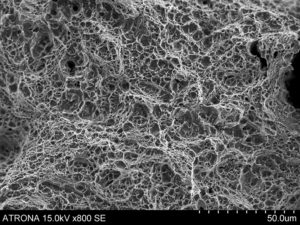SEM/EDS Lab
SEM/EDS LAB
- Materials Testing
- CHARPY IMPACT TESTING
- CHEMICAL ANALYSIS LAB
- FAILURE ANALYSIS LAB
- FASTENER TESTING
- HARDNESS AND MICRO-HARDNESS TESTING
- HEAT TREATMENT SUPPORT
- MAGNETIC PARTICLE INSPECTION
- MECHANICAL TESTING
- METALLURGICAL TESTING LAB
- MICROSTRUCTURE ANALYSIS
- POLYMER TESTING
- SALT FOG TESTING
- SEM/EDS LAB
- SURFACE FINISH CONSULTING
- TENSILE TESTING LAB

SCANNING ELECTRON MICROSCOPY (SEM) AND ENERGY DISPERSIVE X-RAY SPECTROSCOPY (EDS).
Scanning Electron Microscopy (SEM) and Energy Dispersive X-Ray Spectroscopy (EDS) with full digital imaging has emerged as an essential tool in metallurgical testing and failure analysis. Using a beam of highly energetic electrons, SEM allows us to acquire live, high-resolution, micro scale, three-dimensional images of the surface of a failed metal part or component. Using these digital images with a magnification of up to 500,000x, we are able to study the fracture topography and morphological characteristics of the failed metal part or component to determine the failure mode and root cause. Scanning electron microscopy with EDS is also used for determining the chemical composition of constituents in the microstructure, determining plating types, finding and chemically analyzing contamination, and more.
At QAI we have two full SEM/EDS systems. One of these systems features cutting-edge technology in the field of microscopy giving us an advantage with clear imaging and EDS mapping capabilities. The other SEM was upgraded with new software and controls. One of our SEM’s is capable of variable pressure allowing us to perform analysis on plastics and all non-conductive materials.
QAI’S SEM CAPABILITIES INCLUDE:
- Revolutionary automatic alignment functions; auto beam setting, auto aperture, etc.
- Better resolution of any of its kind due to new electron optics
- Real time full screen image, dual image and signal mixing
- Newly developed high sensitivity solid state type BSE detector
- Computer eucentric, 5-axis motorized stage with motorized tilt
- Can accommodate sample as tall as 85 mm for elemental analysis without cutting
- Analytical specimen chamber with optimum geometry for simultaneous accommodation of EDS
- Variable pressure allows observations of wet, oily, and non conductive samples (polymers)
EDAX FULL ENERGY DISPERSIVE X-RAY SPECTROSCOPY CAPABILITIES:
- Qualitative analysis
- Quantitative analysis
- Elemental Mapping and Scanning
- Fast and Accurate plots of elemental distributions
- Powerful automated particle analysis
- Automated spectrum collection
EVALUATING FAILURE MODE WITH SEM
SEM allows us to acquire live, high-resolution, micro scale, three-dimensional images of the surface of a failed metal part or component. Using these digital images or “photomicrographs” with a magnification of up to 500,000x, failure modes are easily revealed and identified. Even if the fracture face is corroded or has other contamination, QAI has ways to clean the fracture surface to reveal the mode of failure. Fracture initiation can also be revealed.
Generally speaking, failure modes are either ductile or brittle. Ductile failures are typically accompanied by significant plastic deformation. Brittle failures are normally accompanied by no elongation or plastic deformation. They produce catastrophic failures with little to no strain. Ductile fractures are more desirable than brittle fractures because generally ductile fractures give warnings prior to a catastrophic event.
Specific failure modes include Dimple Rupture Overload, Microvoid Coalescence, Intergranular and Transgranular, Stress Corrosion Cracking, Hydrogen Embrittlement, Gaping Grain Boundaries, Cleavage Rupture, Creep and Elongation, Tensile and Compressive Modes, Corrosion (various types), Fatigue (High and Low Cycles & High and Low Loads), Lamination and Streaking, Embrittlement, and others.
Highlights
SPECIFIC TESTS AND/OR PROPERTIES MEASURED
METALS AND METALLIC COMPONENTS
TEST METHODS
• Image Analysis
• Quantitative Analysis
• Elemental Mapping and Scanning
APPLICABLE STANDARDS
ASTM E1508, Atrona MET-08, and other Test Methods in Scope of Accreditation
KEY EQUIPMENT OR TECHNOLOGY
• Scanning Electron Microscopy (SEM)
• Energy Dispersive X-Ray Spectroscopy (EDS)
For more information about our services please contact us at:
📞 USA 888.540.4024 📞 CANADA 877.461.8378

Founded in 1995 by a group of experienced certification and testing experts, QAI is an independent third-party testing, inspection and certification organization which serves the building industry, government and individuals with cost effective solutions through our global, in-house capabilities / services.
Latest News
-
Join QAI’s Impartiality Committee!
Be the Voice of Impartiality – Join QAI’s Impartiality Committee! Are you
19 December, 2024 -
2023 Alberta Edition of the National Building Code
Dear Valued Client, Subject: Announcing the publication of the 2023 Alberta Edition
5 April, 2024 -
QAI LABORATORIES (QAI) AND ATRONA TEST LABS (ATL) JOIN FORCES TO EXPAND TESTING CAPABILITY
QAI Laboratories is pleased to announce the acquisition of ATRONA Test Labs,
18 March, 2024
Services
Contact
 USA 1(888)540.4024
USA 1(888)540.4024
 Canada 1(877)461.8378
Canada 1(877)461.8378
 Europe info@qai.org
Europe info@qai.org
 China china-info@qai.org
China china-info@qai.org
 S Korea asia-info@qai.org
S Korea asia-info@qai.org








